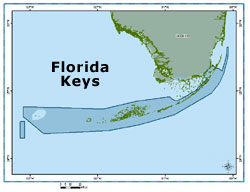|
 Protecting Coral Reefs Protecting Coral Reefs
NOAA scientists have long led the world in developing techniques for restoring coral reefs damaged by vessel groundings. Now, a comprehensive effort to monitor the recovery of damaged reefs documented the structural stability and replenishment of marine life of these projects. Structures are made of concrete and/or limestone and used to repair damaged reefs. The structures withstood winter storms and the effects of four hurricanes in 2005. Most encouraging, juvenile hard and gorgonian corals began settling on restored sites.
If they survive, coral populations on restored reefs could begin to match those of natural reefs over time. Surveys of fish, lobster and other invertebrates demonstrate that restoration projects provide ample habitat for an array of species to thrive. Funds from legal settlements against boaters who have run aground pay for the monitoring program.
Detective Work Continues on Mystery Wreck
NOAA and State of Florida staff investigated an unknown wooden shipwreck disguised by coral in the shallow waters near Marathon. Archaeologists suspect that the wreck is from the 1600s and are excited because few shipwrecks have been documented from this period. The previous most significant finds to date in the Florida Keys have been from wrecks of a 1733 Spanish fleet.
State and federal archaeologists converged on the site in June 2005 to document the wreck for the first time since the sunken ship was discovered in the early 1970s and hunting for clues that may help shed light on its murky past. Based on a preliminary assessment of the expedition’s findings, archaeologists believe that the wreck was likely a small 17th-century Spanish vessel—possibly a messenger ship or scout—which would make it more than 300 years old. A novel technique, coral sclerochronology, helped date the wreck by determining the age of coral growing atop its ballast stones.
The ship, which ran aground on one of the areas many patch reefs, was probably salvaged of all valuable equipment before it sank. While there is currently no final word on the vessel’s identity, researchers will continue to study the expedition’s findings in the months to come in the search for further clues. Click here for photos of the researchers at work at the mystery wreck.
Investigation Leads to Discovery of Illegal Lobster Habitats
In an effort to stop the illegal take of spiny lobsters in the Florida Keys, state and federal law enforcement officials mounted a five-week investigation to enforce a state law prohibiting the taking of lobsters from illegally placed artificial structures. The illegal structures range from car hoods to 55-gallon drums, and have the potential to damage seagrass and corals during placement or when they are tossed by storms. They also expose spiny lobster populations to increased fishing pressure.
The investigation resulted in several citations and warnings, destruction of 33 illegally placed sites and documentation of coordinates for another 135 possible sites. Though long practiced on a small scale, the recent proliferation of illegal, artificial structures is suspected by sanctuary managers to be altering the normal spawning and migration patterns of the spiny lobster. Investigating officers submitted several recommendations for improving enforcement methods.
Exclusive Stories for the Web
No-Take Reserve Contains More and Bigger Lobster
Within the Florida Keys sanctuary, different types of marine zones have been established to protect marine life and provide areas for recreation. To determine how effective the zones are at protecting marine life, a monitoring program was established as part of a comprehensive effort to gauge the effects of the sanctuary network of 24 no-take areas. Click here for a more detailed story with supporting graphics.
Partnership to Heighten Coral Bleaching Vigilance
The sanctuary and Mote Marine Laboratory launched BleachWatch, an innovative effort to provide early warning and quick response to mass coral bleaching by integrating volunteer monitoring, scientific assessment and public outreach. Volunteer divers have been trained to gauge reef susceptibility to bleaching and record location, frequency and intensity of events. Data is available online.
New Sanctuary Brochures
Florida Keys general and upper region brochures were rewritten and refreshed to include updated graphics and sanctuary information. In response to public inquiries, a spearfishing brochure was also created to collect and define the multitude of rules governing the use of spear gear within the sanctuary.
 Plans for 2006 Plans for 2006
NOAA published the Florida Keys sanctuary draft revised management plan with the final plan expected in early 2006.
In addition, the Dr. Nancy Foster Environmental Complex will open and include offices, vessel facilities and the Florida Keys Eco-Discovery Center. A new 53-foot high-speed, Teknicraft catamaran will join the sanctuary fleet, which will enhance law enforcement patrols in the sanctuary’s remote Tortugas region. The boat will be dedicated as the Peter Gladding in honor of a longtime Key West commercial fisherman who helped establish the reserve.
The site is also working with partners to unveil a maritime heritage exhibit featuring an 18th century cannon at the Key Largo Chamber of Commerce visitor center. Sanctuary volunteer Denis Trelewicz advocated for the cannon’s recovery and paid for its conservation by the Mel Fisher Maritime Heritage Museum.
|



